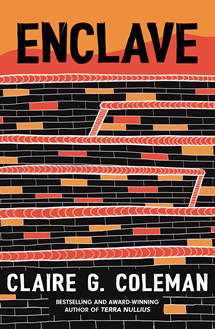Reviewed by Robert Goodman.
By Claire G Coleman, Hachette, $29.99.
 Claire G Coleman burst onto the scene with her allegorical but pointed debut Terra Nullius. In that book, Coleman used a science fiction premise, an alien invasion of Earth, to interrogate the history of colonisation of Australia. She continued on this theme, although in a very different way in The Old Lie, which drew on a different set of science fiction tropes – in that case the galactic empire and galaxy spanning war. In her third book, Enclave, she draws on some other classic science fiction traditions – the Orwellian dystopia mixed with a touch of solarpunk – to explore current issues.
Claire G Coleman burst onto the scene with her allegorical but pointed debut Terra Nullius. In that book, Coleman used a science fiction premise, an alien invasion of Earth, to interrogate the history of colonisation of Australia. She continued on this theme, although in a very different way in The Old Lie, which drew on a different set of science fiction tropes – in that case the galactic empire and galaxy spanning war. In her third book, Enclave, she draws on some other classic science fiction traditions – the Orwellian dystopia mixed with a touch of solarpunk – to explore current issues.
Christine lives in the walled city of Safetown. She is part of the Safetown elite and is being groomed to follow in her parents’ footsteps. Christine knows that the world outside is violent and dangerous, and is constantly being told that only within the walls is she safe. But Christine is dissatisfied with her life, she doesn’t want what her parents want for her. An attraction to one of the female servants exacerbates her feelings until she breaks the strict code of the town and is exiled into the wastelands outside the walls. But this is just the start of Christine’s odyssey into the world outside of Safetown which she finds is not everything she was brought up to believe.
The idea of a community living in a walled enclave, is only a very slight extrapolation from very real elements of the current world. The inhabitants are all white and well-heeled; the servants are all darker skinned and are bussed in and out from outlying settlements; anything that deviates from a hetero-normative ideal is seen as perverse; there is constant surveillance by fixed cameras and drones and social media is restricted and controlled. Building these ideas into a dystopian tale, Coleman clearly draws on elements of classic dystopias from 1984, The Giver and The Handmaid’s Tale and more recent offerings such as The Wall. So that Enclave does not bring very much new to the dystopian table.
More interesting, and slightly less ubiquitous in speculative fiction at the moment, are the solarpunk elements of the book. Although these are handled in a way to make them seem more like wishful thinking developed in opposition to a dystopian construct rather than a realistic, potential future.
While Coleman’s earlier books are designed to make readers reconsider and recontextualise their understanding of the historical issues this book does not achieve that. It is much more along the lines of good (environmental consciousness, gender and cultural diversity, real news, no walls) versus evil, with the “bad” guys themselves such stereotypes as to be not particularly believable. So while Coleman’s message is a worthy one – tolerance, understanding, openness and respect for the environment – it is delivered with a distinct lack of subtlety that undermines it.
Over 800 more book reviews can be found on Pile by the Bed.











